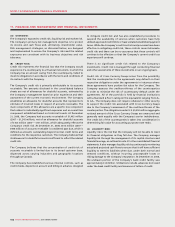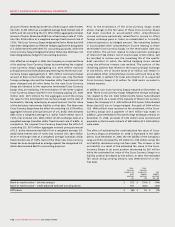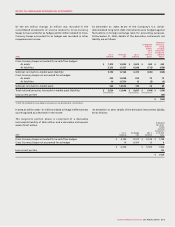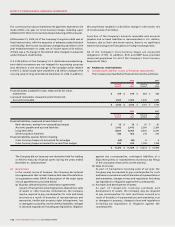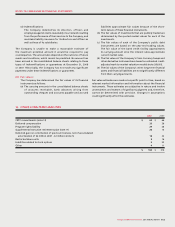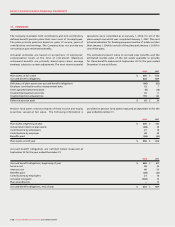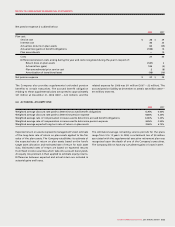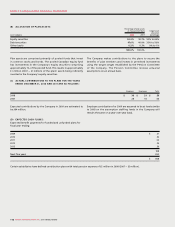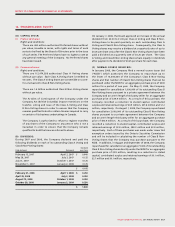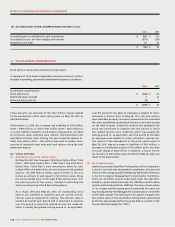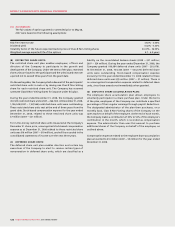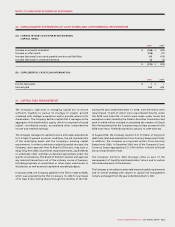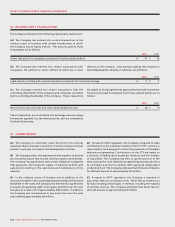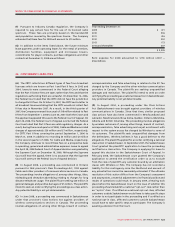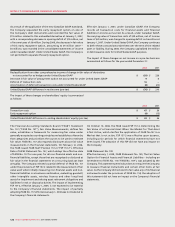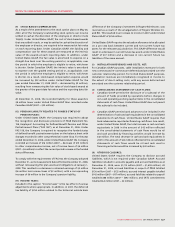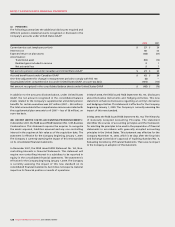Rogers 2008 Annual Report Download - page 122
Download and view the complete annual report
Please find page 122 of the 2008 Rogers annual report below. You can navigate through the pages in the report by either clicking on the pages listed below, or by using the keyword search tool below to find specific information within the annual report.
118 ROGERS COMMUNICATIONS INC. 2008 ANNUAL REPORT
NOTES TO CONSOLIDATED FINANCIAL STATEMENTS
over the period to the date an employee is eligible to retire,
whichever is shorter. Prior to May 28, 2007, all stock options
were classified as equity and were measured at the estimated
fair value established by the Black Scholes or binomial models
on the date of grant. Under this method, the estimated fair
value was amortized to expense over the period in which
the related services were rendered, which was usually the
vesting period or, as applicable, over the period to the date
an employee was eligible to retire, whichever was shorter.
The impact of the amendment to the stock option plans at
May 28, 2007, was an increase in liabilities of $502 million, a
decrease in contributed surplus of $50 million and a one-time
non-cash charge of $452 million. In addition, a future income
tax recovery of $160 million was recorded on May 28, 2007, as a
result of the amendment.
(ii) Stock option plans:
Options to purchase Class B Non-Voting shares of the Company on
a one-for-one basis may be granted to employees, directors and
officers of the Company and its affiliates by the Board of Directors
or by the Company’s Management Compensation Committee.
There are 30 million options authorized under the 2000 Plan,
25 million options authorized under the 1996 Plan, and 9.5 million
options authorized under the 1994 Plan. The term of each option
is 7 to 10 years and the vesting period is generally four years but
may be adjusted by the Management Compensation Committee
on the date of grant. The exercise price for options is equal to the
fair market value of the Class B Non-Voting shares determined
as the five-day average before the grant date as quoted on the
Toronto Stock Exchange (the “TSX”).
Stock options, share units and share purchase plans:
A summary of stock-based compensation expense (recovery), which is
included in operating, general and administrative expense, is as follows:
19. STOCK-BASED COMPENSATION
(D) ACCUMULATED OTHER COMPREHENSIVE INCOME (LOSS):
2008 2007
Unrealized gain on available-for-sale investments $ 205 $ 351
Unrealized loss on cash flow hedging instruments (377) (335)
Related income taxes 77 34
$ (95) $ 50
2008 2007
Stock-based compensation:
Stock options (A) $ (104) $ 34
Restricted share units (B) 7 21
Deferred share units (C) (3) 7
$ (100) $ 62
These amounts are exclusive of the $452 million charge related
to the amendment of the stock option plans on May 28, 2007, as
described below:
At December 31, 2008, the Company had a liability of $278 million
(2007 – $493 million), of which $267 million (2007 – $455 million) is
a current liability related to stock-based compensation recorded
at its intrinsic value, including stock options, restricted share units
and deferred share units. During the year ended December 31,
2008, $106 million (2007 – $80 million) was paid to holders upon
exercise of restricted share units and stock options using the cash
settlement feature.
(A) STOCK OPTIONS:
(i) Amendments to stock option plans:
On May 28, 2007, the Company’s 1994 Stock Option Plan (“1994
Plan”), 1996 Stock Option Plan (“1996 Plan”) and 2000 Stock
Option Plan (“2000 Plan”) were amended to allow for cash
settled SARs to be attached to all new and previously granted
options. The SAR feature allows option holders to elect to
receive an amount in cash equal to the intrinsic value, being
the excess market price of the Class B Non-Voting share over
the exercise price of the option, instead of exercising the
option and acquiring Class B Non-Voting shares.
As a result, effective May 28, 2007, all outstanding stock
options are classified as liabilities and are carried at their
intrinsic value as adjusted for vesting. The intrinsic value is
marked-to-market each period and is amortized to expense
over the period in which the related services are rendered,
which is usually the graded vesting period or, as applicable,


